

Hotline:0755-22277778
Tel:0755-22277778
Mobile:13826586185(Mr.Duan)
Fax:0755-22277776
E-mail:duanlian@xianjinyuan.cn
The 5G era has arrived, and due to its high-frequency and high-speed characteristics, there will be significant changes in the material end. LCP has encountered such a 0 → 1 development opportunity, and with its low impedance and high resistance, it is expected to become the most suitable material. With the increase of 5G frequency, the penetration rate of LCP materials and their products will gradually increase, which is expected to rapidly increase the entire LCP market to over 10 billion yuan.
1. LCP Material: Excellent New High Performance Special Engineering Plastic
liquid crystal polymerLCP refers to a polymer that can exist in the liquid crystal phase under certain conditions, characterized by high molecular weight and oriented order. When LCP exists in the liquid crystal phase, its viscosity is low and it is highly oriented. However, after cooling and curing, its morphology can be stably maintained, thus LCP material has excellent mechanical properties. In addition,LCP materialDue to its low moisture absorption, chemical corrosion resistance, weather resistance, heat resistance, flame retardancy, as well as low dielectric constant and dielectric loss factor.
LCP can be divided into two types based on the conditions for forming liquid crystal phases: (1) lyotropic liquid crystal LLCP, which can form liquid crystal phases in organic solutions. As this type of polymer can only be processed in solution and cannot melt, it can be used as fibers and coatings. (2) Thermotropic liquid crystal TLCP forms a liquid crystal phase above the melting point or glass transition temperature. As this type of polymerization can be processed in a molten state, it can not only form high-strength fibers through solution spinning, but also various products through thermal processing methods such as injection and extrusion. The LCP we are discussing in this article is mainly thermally induced liquid crystal TLCP.
Thermotropic LCP can be classified into high heat resistance type (Type I), medium heat resistance type (Type II), and low heat resistance type (Type III) based on the temperature of thermal deformation. The basic structure of Type I TLCP is mainly composed of units derived from para hydroxybenzoic acid (HBA), hydroquinone (BP), and different proportions of terephthalic acid (TA)/isophthalic acid (IA). The tensile strength and modulus are the highest in TLCP, and the hot deformation temperature is above 300 ℃. Represented by Xydar from Suwei and SimikaSuper from Sumitomo. The main components of Type II TLCP are HBA and units derived from 6-hydroxy-2-naphthoic acid (HNA). The hot deformation temperature is between 240~280 ℃, and the processing performance is excellent. It can be processed and formed by extruders and injection molding machines. The typical product is TECONA's Vectra. Type III LCP is mainly a copolymer synthesized from HBA and polyethylene terephthalate (PET), with a heat deformation temperature below 210 ℃, such as the non fully aromatic series represented by Rodrun from Unichka.
Figure 1: Several typical LCP structural units

LCP material has excellent heat resistance and formability. The main polymerization method is melt condensation, and fully aromatic LCP is often supplemented by solid-phase condensation to produce high molecular weight products. Non fully aromatic LCP plastic raw materials are often produced through one-step or two-step melt polymerization. In recent years, the technology of continuous melt condensation to produce high molecular weight LCP has been developed. Liquid crystal aromatic polyester, due to the orientation of its large molecular chains in the liquid crystal state, has an abnormally regular fibrous structure, special properties, and high product strength, which is not inferior to metals and ceramics. Good mechanical performance, dimensional stability, optical performance, electrical performance, chemical resistance, flame retardancy, processability, good heat resistance, and low coefficient of thermal expansion.
Figure 2:LCP materialExcellent performance
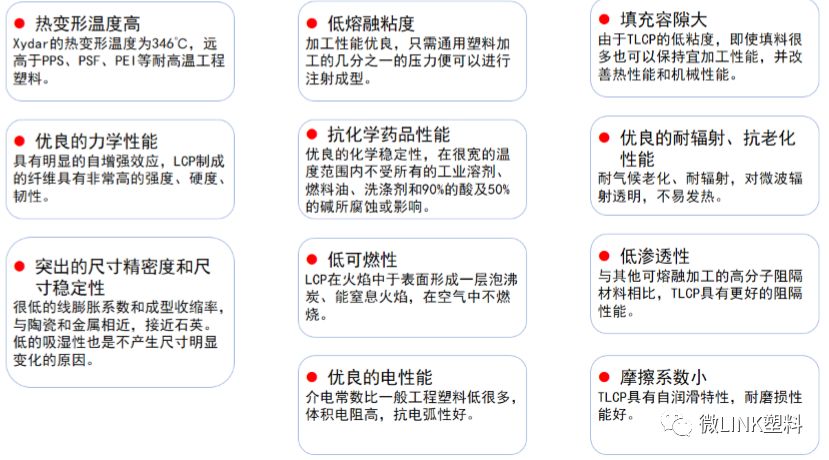
2. Industry chain: The upstream and midstream are technical difficulties, while the downstream is widely used
In the LCP industry chain,LCP resinThe synthesis and film formation are technical difficulties. At present, the mainstream synthesis methods for LCP resin include the following four.
(1) Oxidative esterification method: Oxidative esterification is a direct polymerization method of aromatic carboxylic acids and phenols. This method reacts in pyridine or amide solvents with phosphorus containing compounds or thionyl chloride activators and catalysts to obtain high molecular weight LCP. The reaction conditions are mild and the molecular structure sequence can be controlled by the order of monomer addition.
(2) Silicon ester method: Aromatic acid monomers are esterified with trimethylsilyl, and then reacted with acetylated phenolic monomers through solution or melt polymerization processes to remove small molecules of trimethylsilyl acetate, resulting in high molecular weight LCP.
(3) Phenyl ester method: a method of melt condensation of aromatic carboxylic acid phenyl esters with phenolic monomers. However, the aromatic carboxylic acid phenyl ester used in this method is relatively expensive and generates small molecules of phenol that are difficult to remove completely during the reaction process. Recently, Sumitomo Chemical has synthesized LCP with low acetic acid residue through a "one-step" synthesis process using diphenyl carbonate and phenolic monomers, and the resin has good flowability, making it a potentially advantageous synthesis process.
(4) Acid hydrolysis reaction method: Aromatic dicarboxylic acids are melt condensed with acetylated phenolic monomers to remove the byproduct acetic acid and obtain LCP. This method is currently the main method for industrial production of LCP.
3. The processing methods of LCP mainly include the following four types.
(1) Injection molding: Injection molding is the most important molding method for LCP. LCP not only has excellent processing fluidity, but also has a fast curing speed, making it suitable for processing using injection molding methods. Compared to polyphenylene sulfide (PPS) and high-temperature resistant nylon (HT-PA), the parts have advantages such as no burrs. However, due to the rigid rod-shaped nature of LCP molecular chains, they are easily oriented along the flow direction, resulting in performance differences between molded parts parallel and perpendicular to the flow direction, as well as strong weld lines
Disadvantages such as poor degree. In recent years, defects such as poor weld strength and anisotropy have been improved to some extent through mold design and other methods.
(2) Extrusion molding: The extrusion molding method is commonly used in the production of plastic films and pipes. Due to the anisotropy of LCP, the performance of LCP films processed by traditional extrusion technology in the transverse direction of melt flow is weak. Therefore, currently LCP is generally formed into multi-layer films or pipes through co extrusion processing with other isotropic materials such as PET, ethylene vinyl alcohol copolymer (EVOH), etc.
(3) Solution casting molding: LCP has a low coefficient of thermal expansion, excellent dimensional stability, low moisture absorption, excellent high-frequency characteristics, and electrical insulation properties, making it widely used in high-frequency circuit substrates. Flexible printed boards and embedded circuit boards require flexible layout and high-density wiring, thus requiring very high molding process requirements. Traditional injection molding, extrusion and other methods are difficult to meet their process requirements. Sumitomo Chemical produces LCP resin through special molecular design, which is then dissolved in a special solvent and molded by solution cast to obtain a thin film with excellent strength and flexibility. The solvent used is different from the commonly used fluorinated phenol solvents and has strong operability. And the parts formed by solution casting avoid the anisotropic defects caused by injection molding and extrusion molding. At the same time, more complex substrates can be formed and more fillers can be mixed in. At present, the LCP thin film parts processed by this method are being promoted and used in circuit boards.
(4) Blow molding: LCP has excellent gas permeability and solvent resistance, and can be blown into hollow molded products or film parts with excellent barrier properties, such as fuel tanks and various piping in automotive components. However, the low tension of LCP melt leads to severe sagging, making it difficult to prepare molded products of the desired shape through blow molding.
At present, the global production capacity of LCP resin materials is about 76000 tons per year, all of which are concentrated in Japan, the United States, and China, with production capacities of 34000 tons, 26000 tons, and 16000 tons, accounting for 45%, 34%, and 21% respectively. American and Japanese companies began mass producing LCP materials in the 1980s, while China entered the LCP field relatively late and has long relied on imports from the United States and Japan. In recent years, with the successive production of companies such as Jinfa Technology, Pulite, Wote Co., Ltd., and Jujia New Materials, the production capacity of LCP materials has grown rapidly. With the arrival of the 5G era, the demand for LCP materials is expected to experience rapid growth in the future.
1. Market Pattern: Led by the United States and Japan, the rise of domestic materials is imminent
The development of specialized resins and films for domestic films started late,LCP filmThe production of resin and film is almost monopolized by Japan and the United States. Multiple Japanese and American manufacturers in the LCP industry chain have vertical integration capabilities. Sumitomo Group (Sumitomo Chemical/Sumitomo Electric) is currently the only manufacturer with integrated production capabilities from LCP resin to modules. Murata Manufacturing Company integrated upstream through the acquisition of LCP film manufacturer Primatec from Japan in 2016, and has the ability to produce LCP film to soft board integration (the film withdrew from the LCP antenna module business in 2017). Fujikura Electronics in Japan has the production capacity of CongLCP soft boards to modules, and has advantages in high-frequency microwave soft boards and high-speed interface transmission lines.
There are many suppliers of LCP resin materials, but very few can be commercially used for LCP multilayer boards. LCP resin material leaders such as Baoli Plastic, Sumitomo Chemical, and Celanese have been developing and commercializing LCP since 1985. Domestic manufacturers such as Waters Corporation, Pruitt, Jinfa Technology, and Jujia New Materials have successfully entered the LCP resin market.
Table 1: Major Global Producers of Liquid Crystal Polymers
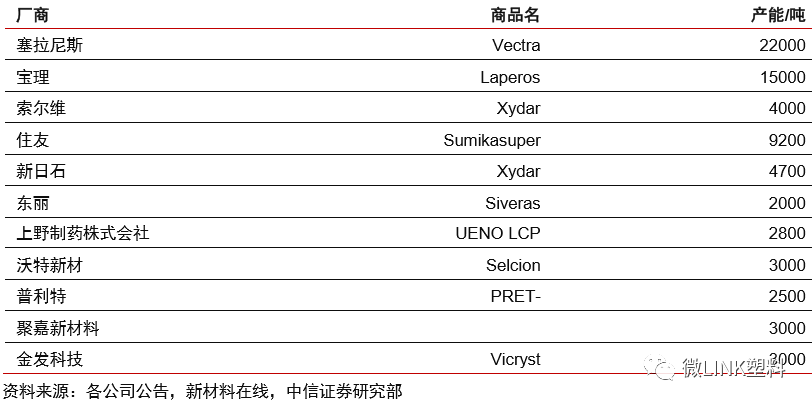
2. The downstream application fields of LCP materials continue to expand
LCP has a wide range of downstream applications. LCP combines the characteristics of polymer materials and liquid crystal materials, and has outstanding comprehensive performance. It has been widely used in fields such as aerospace, electronics, and automotive industry. Meanwhile, with the development of new LCP products, emerging application areas are still expanding.
Figure 3: LCP has a wide range of downstream applications
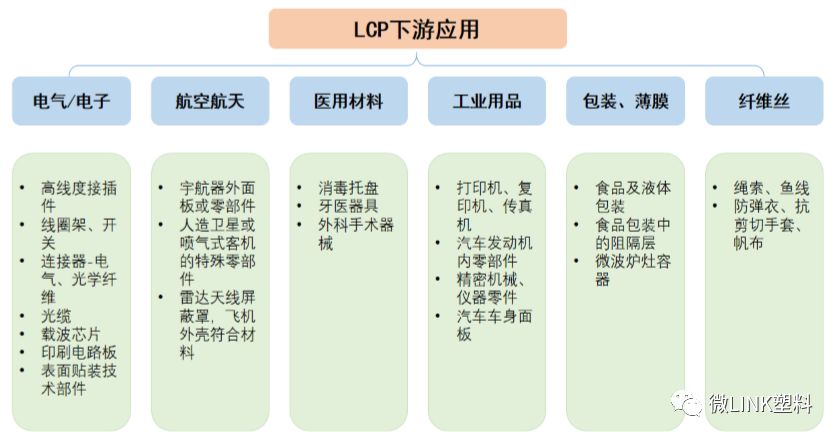
In 2019, the global demand for LCP was around 74000 tons, mainly used in the early stage of electronics. With the rapid growth of demand in areas such as 5G in the future, the demand for consumer electronics and electronic appliances is expected to increase rapidly.
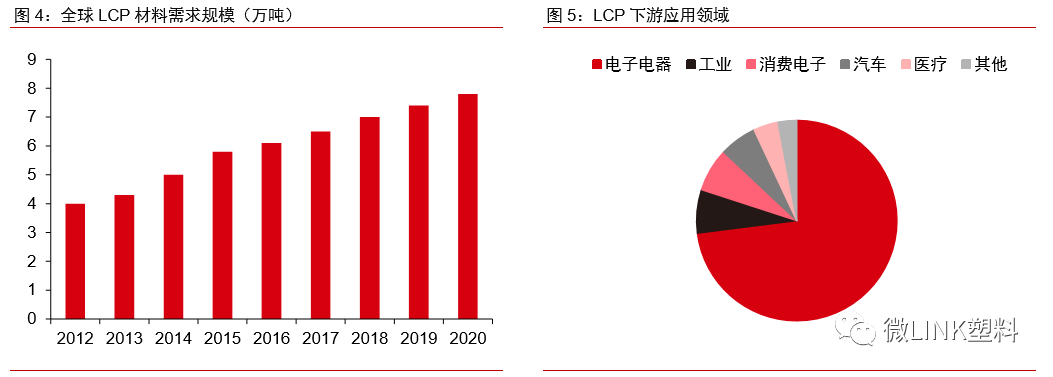
The 5G era is gradually approaching, and due to the high-frequency and high-speed characteristics of 5G, the requirements for materials are further increasing, especially in reducing losses during signal transmission, which is very important. LCP is currently the material with the lowest dielectric loss in the field of engineering plastics, and has the strongest comprehensive advantage. We believe that the use of LCP materials will be significantly increased in both base stations and mobile phones in the future.
Figure 6: Introduction to LCP Materials
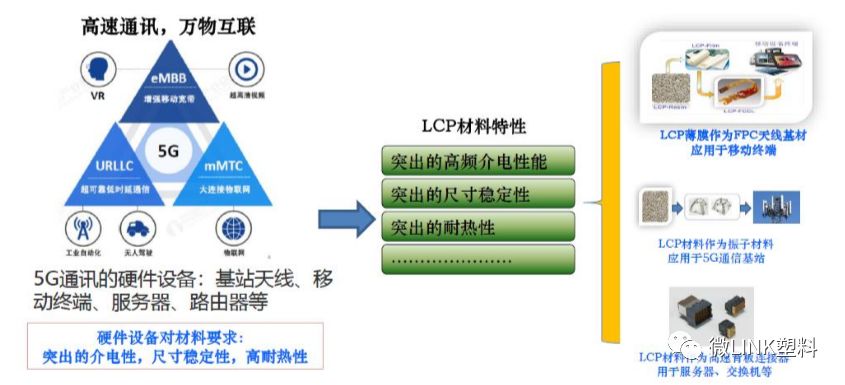
1. On the mobile end, LCP module is expected to become a terminal solution for mobile antenna end
In the field of 5G mobile phones, LCP is the material that best meets antenna requirements from a technical perspective due to its excellent transmission loss, bendability, dimensional stability, and low water absorption.


At present, the PI substrate FPC antenna module is still the mainstream design solution for mobile phones. But with the advent of the 5G era, it is expected that FPC on MPI and LCP substrates will accelerate their replacement. Taking Company A as an example, the antenna scheme of LCP soft board was first introduced in iPhone 8. In 2018, the three models XR/XS/XS Max continued to use LCP antenna scheme, using 3/3/2 LCP antennas respectively. We believe that Company A is laying out ahead for the 5G era.
At present, MPI has significantly improved its performance by adjusting its formulation, and its performance is comparable to LCP in the Sub-6GHz spectrum (but there is still a gap in the millimeter wave spectrum), with a cost 20-30% lower than LCP antennas. Furthermore, from the perspective of the supply chain, currentlyLCP filmBasically monopolized by Japanese companies, MPI has far more suppliers than LCP. From the perspective of supply chain stability and bargaining power, Company A has reduced the number of LCP antennas in the short term; However, considering the long-term release of domestic production capacity and gradual breakthroughs in technology, we believe that with the gradual localization of LCP film materials, the cost of LCP based soft boards will significantly decrease, and the market will accelerate expansion.


According to Yole's 5G development roadmap, the future communication frequency will be increased in two stages. The goal of the first phase is to increase the communication frequency to 6GHz before 2020, and the goal of the second phase is to further increase it to 30-60GHz after 2020. In terms of market applications, the signal frequency of terminal antennas such as smartphones continues to increase, and high-frequency applications are becoming more and more common. The demand for high-speed and large capacity is also increasing. To adapt to the current high-frequency and high-speed trend from wireless networks to terminal applications, as antennas and transmission lines in terminal devices, we believe that the MPI antenna in the soft board may only be a transition, and the main market in the future will beLCP antenna.
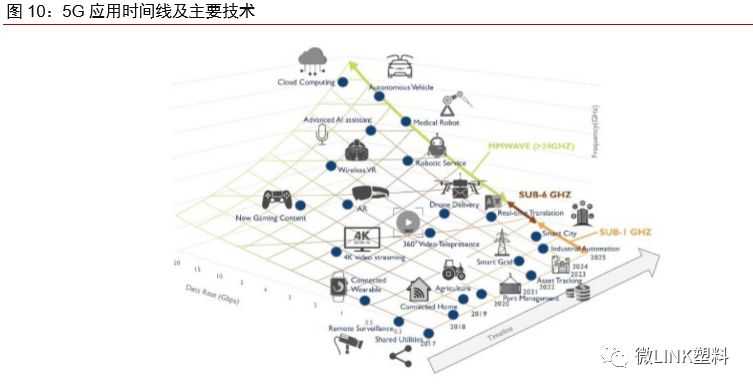
2. At the base station end, LCP oscillators are expected to become the mainstream route
5G base stations have stricter requirements for oscillators: (1) Highly integrated, active antenna units (AAUs) integrate RRUs and AAUs, supporting more antenna frequency bands to improve production efficiency. SMT has become the manufacturing process for AAUs, and antenna oscillator materials can withstand temperatures exceeding 260 ℃. (2) Massive MIMO and beamforming antenna technology require more antennas and lightweight materials, with plastic antenna elements becoming a trend. (3) The electromagnetic wave attenuation in the millimeter wave band is high, requiring antenna oscillator materials to have low dielectric loss.
At present, there are roughly three types of antenna oscillators on the market: metal die casting, PCB mounting, and plastic oscillators. Among them, plastic oscillators have two process schemes: LDS (laser direct molding technology) and selective electroplating. The antenna elements in the 4G era are mainly made of metal materials, and the manufacturing processes are mainly casting and sheet metal processes. They have a large weight and volume, and the signal transmission accuracy cannot meet the requirements of the 5G era very well; Although PCB mounting is lightweight and cost-effective, it has high surface loss and high requirements for construction and installation.
By modifying plastic materials and using injection molding to produce the shape of the antenna oscillator in one go, and then using special technology to metal the plastic surface of the oscillator, compared with sheet metal and die-casting processes, 3D plastic oscillators not only have advantages in weight, but also meet the accuracy requirements that sheet metal and die-casting processes cannot achieve. They can better adapt to high-frequency scenarios above 3.5GHz and will become the mainstream solution for antenna oscillators in the 5G era.

The current mainstream modified plastic solution used for oscillators is mainly PPS (polyphenylene sulfide). Compared with PPS material, LCP material has the advantages of low dielectric loss, good weather resistance, and low overall cost, and is expected to accelerate its entry into the supply chain system in the future.

We calculate the demand space for LCP in the future market separately based on the mobile phone end and the base station end.
We have made the following assumptions:
1) On the mobile end, the penetration rates of the Apple system in 2019, 2020, 2021, 2022, and 2025 are 50%, 75%, 100%, 100%, and 100%, respectively; The penetration rates of the Android system are 0%, 7%, 14%, 21%, and 40%, respectively;
2) At the base station end, the market share of LCP oscillators will be 0%, 20%, 30%, 40%, and 80% in 2019, 2020, 2021, 2022, and 2025, respectively.
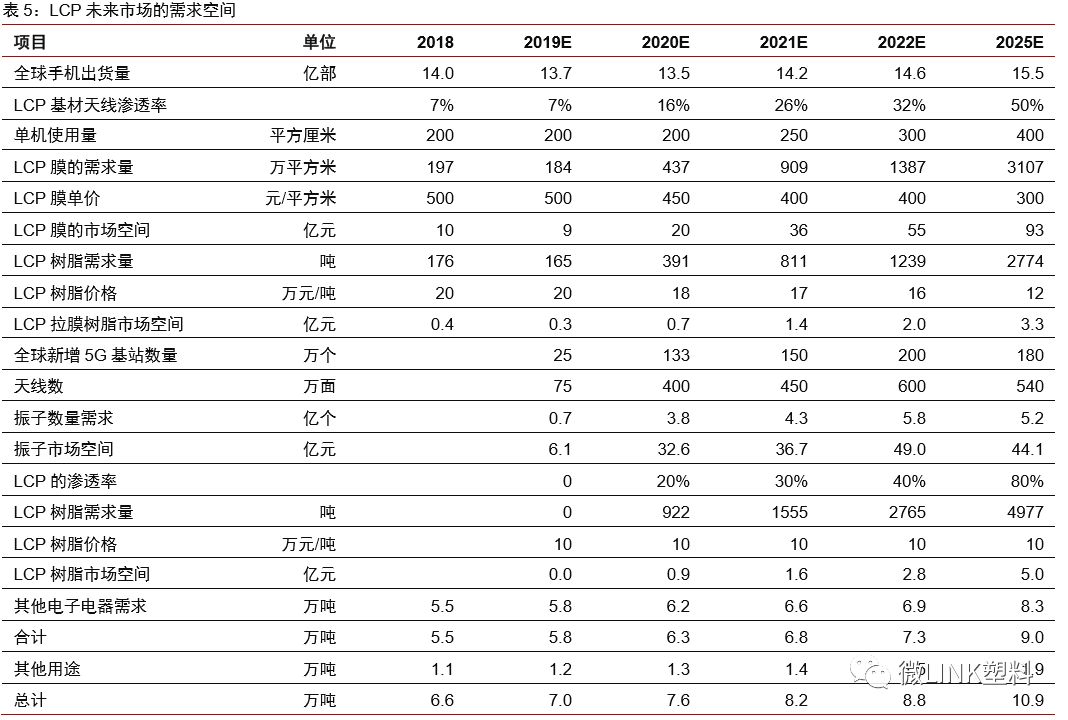
We believe that the LCP market will exceed billions in the future, among whichLCP filmThe market space exceeds billions. At present, The main manufacturers of LCP film are still foreign companies, but some domestic resin and stretch film companies are already conducting sample testing and achieving good results. Currently, they are in the industrial preparation stage, and we expect that some companies will form substantial sales in the second half of 2020.
The demand for LCP resin will grow rapidly, and it is expected that the total demand of the industry will double in the next 5 years, with a rapid increase in demand for high-end grades suitable for film pulling.


Advanced Institute (Shenzhen) Technology Co., Ltd, © two thousand and twenty-onewww.avanzado.cn. All rights reservedGuangdong ICP No. 2021051947-1 © two thousand and twenty-onewww.xianjinyuan.cn. All rights reservedGuangdong ICP No. 2021051947-2